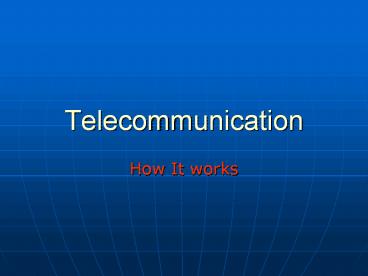Telecommunication - PowerPoint PPT Presentation
1 / 21
Title:
Telecommunication
Description:
Telecommunication How It works What It is? Telecommunication, devices and systems that transmit electronic or optical signals across long distances. such as a ... – PowerPoint PPT presentation
Number of Views:133
Avg rating:3.0/5.0
Title: Telecommunication
1
Telecommunication
- How It works
2
What It is?
- Telecommunication, devices and systems that
transmit electronic or optical signals across
long distances. such as a telephone system. - enables people to send and receive personal
messages . - key medium for delivering news, data,
information, and entertainment.
3
Way of sending Message
- Point-to-point One sender to a single receiver
such as telephone conversation - Point-to multi point one sender to many
receiver such as television, It often called
Broadcast
4
How the signals sent?
- Telecommunications devices convert different
types of information, such as sound and video,
into electronic or optical signals. - Electronic signals travel along a medium such as
copper wire or are carried over the air as radio
waves. Optical signals travel along optical fiber
cable - the device on the receiving end converts the
signal back into an understandable message, such
as words and pictures on a computer screen.
5
Types of signal
- analog or digital refers to the method used to
convert information into an electrical signal
- Analog signal
- Digital signal
- Optical signal
6
Analog signal
- An analog signal is any continuously variable
signal - in an analog sound recording, the variation in
pressure of a sound striking a microphone creates
a corresponding variation in the current passing
through it. An increase in the volume of the
sound causes the fluctuation of the current to
increase
7
Digital signal
- 0 volt means 0
- 5 volts means 1
8
Optical signal
- Pulse beam of laser light
- LED (Light Emitting Diode) send signal
- Fiber optic receiver Receive fiber optic signals
9
Transmission medium
- Cable
- Fiber-optic
- Micro-wave
- Satellite
10
Coaxial cable
- Developed in 1936
- Made of copper wire
- Expensive
11
Fiber Optics
- Message are digitally coded into pulses of light
- TAT 9 fiber optic cable can carry more than
75,000 telephone conversation at a time
12
Microwave relay
- Relay from station to station
- Needs a clear line of sight between sending and
receiving station - Average distance between stations 40km
- As many as 600 telephone conversations can be
transmitted over one microwave relay channel.
13
Satellite communication
- Started at 1969 with series of satellites
- Orbit 35,880km above the earth
- Powered by solar energy
- Use micro wave for transmission
- can relay up to 33,000 calls simultaneously as
well as several television channels.
14
Way of transmission
- Simplex One way communication
- Half Duplex communications in both directions,
but only one direction at a time - Duplex communication in both directions
simultaneously
15
Applications
- Telegraph
- Fax
- Telephone
- Radio
- Television
- Global Positioning System
- Voice Over IP
16
Computer network
17
Telephone cellular Communication
18
Global Positioning System
- space-based radio-navigation system consisting of
24 satellites and ground support. - accurate information about their position, time,
anywhere in the world and in all weather
conditions.
19
How GPS Works
- GPS satellites fly in circular orbits at an
altitude of 20,100 km (12,500 mi) and with a
period of 12 hours - point their solar panels toward the sun and their
antennas toward the earth - Send the signals to the receiver
- From that signal receiver calculate its position
on earth
20
Application of GPS
- Military equipment such as fighters, bombers,
tankers, helicopters, ships, submarines, tanks,
jeeps, and soldiers - Airplane and ships use it for route navigation
- used to route and monitor delivery vans and
emergency vehicles - car navigation system
- Because the GPS user does not need to communicate
with the satellite, GPS can serve an unlimited
number of users.
21
Inventor
- In 1837 Samuel Morse invented the first workable
telegraph - Alexander Graham Bell invented telephone in 1876
- Marconi invented Radio in 1895































